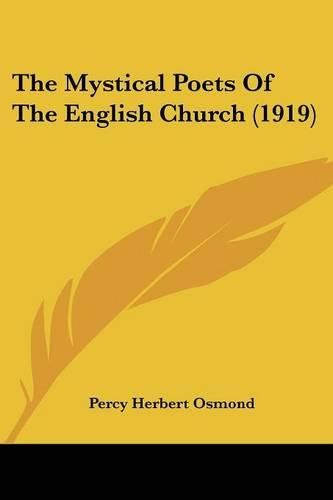Readings Newsletter
Become a Readings Member to make your shopping experience even easier.
Sign in or sign up for free!
You’re not far away from qualifying for FREE standard shipping within Australia
You’ve qualified for FREE standard shipping within Australia
The cart is loading…






Purchase of this book includes free trial access to www.million-books.com where you can read more than a million books for free. This is an OCR edition with typos. Excerpt from book: CHAPTER II. EDMUND SPENSER; GILES AND PHINEAS FLETCHER. AMONG the mystical poets of the English Church place must be found for EDMUND SPENSER, not as the writer of The Faerie Queene, but as the hymnodist of Heavenly Love and Beauty. The Paerie Queene is an allegory, which we read for the noble ethical qualities there personified with an unfailing opulence of music and colour. But allegory and personification are not mysticism: they are not, strictly speaking, Platonism, and it is as a Platonic idealist that Spenser must be considered here. The Renaissance had, as its most important result, the re-introduction of Plato to the intellectual world, and Spenser was the first of our poets to expound that philosopher’s views on Love and Beauty.1 Platonic Idealism, though not in a strict sense mysticism, is closely akin to it; indeed, Dr. Inge has told us that Plato is
the father of European mysticism. Platonism may be described briefly as the love of the invisible and eternal inspired, sustained, and heightened by contemplating the beauty of the visible and the temporal. The locus classicus of the doctrine of Platonic love is the passage in the Symposium (203A, seq in which the Man- tinean prophetess is represented as explaining the origin and meaning of Love. It is there urged that
the right procedure in the matter of Love is to begin with earthly beautiesand to ascend towards that which is Beauty itself, using the former as steps, and from the love of one form to go on to that of two, from two to all beautiful forms, from beautiful forms to beautiful practices, from beautiful practices to beautiful notions, until from beautiful notions the notion of Absolute Beauty is reached, in the knowledge and contemplation of which final satisfaction may be found . 1 Some of the …
$9.00 standard shipping within Australia
FREE standard shipping within Australia for orders over $100.00
Express & International shipping calculated at checkout
Purchase of this book includes free trial access to www.million-books.com where you can read more than a million books for free. This is an OCR edition with typos. Excerpt from book: CHAPTER II. EDMUND SPENSER; GILES AND PHINEAS FLETCHER. AMONG the mystical poets of the English Church place must be found for EDMUND SPENSER, not as the writer of The Faerie Queene, but as the hymnodist of Heavenly Love and Beauty. The Paerie Queene is an allegory, which we read for the noble ethical qualities there personified with an unfailing opulence of music and colour. But allegory and personification are not mysticism: they are not, strictly speaking, Platonism, and it is as a Platonic idealist that Spenser must be considered here. The Renaissance had, as its most important result, the re-introduction of Plato to the intellectual world, and Spenser was the first of our poets to expound that philosopher’s views on Love and Beauty.1 Platonic Idealism, though not in a strict sense mysticism, is closely akin to it; indeed, Dr. Inge has told us that Plato is
the father of European mysticism. Platonism may be described briefly as the love of the invisible and eternal inspired, sustained, and heightened by contemplating the beauty of the visible and the temporal. The locus classicus of the doctrine of Platonic love is the passage in the Symposium (203A, seq in which the Man- tinean prophetess is represented as explaining the origin and meaning of Love. It is there urged that
the right procedure in the matter of Love is to begin with earthly beautiesand to ascend towards that which is Beauty itself, using the former as steps, and from the love of one form to go on to that of two, from two to all beautiful forms, from beautiful forms to beautiful practices, from beautiful practices to beautiful notions, until from beautiful notions the notion of Absolute Beauty is reached, in the knowledge and contemplation of which final satisfaction may be found . 1 Some of the …